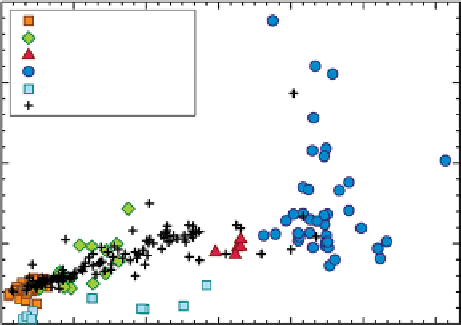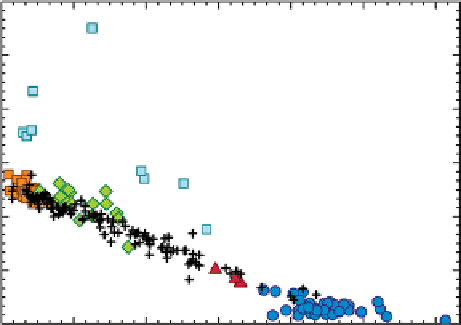Geology Reference
In-Depth Information
2011]. Most eucrites and diogenites are breccias having
been texturally modified by impacts. Howardites are
polymict breccias composed mostly of fragments of eucritic
and diogenitic debris. HED breccias form a continuum
from monomict eucrites through polymict eucrites, how-
ardites, and polymict diogenites to monomict diogenites.
Pyroxenes in HED meteorites vary systematically with
petrologic type. Diogenites contain magnesian orthopyrox-
ene. Most fall within a rather narrow range of compositions
with mg# ~77-74, Wo
~1.5-3.0
. A few magnesian diogenites
have orthopyroxene of mg# 84-79, Wo
~1-2
, and a few fer-
roan diogenites have orthopyroxene compositions of mg#
73-68, Wo
~1-5
. Yamato Type-B diogenites, a lithology transi-
tional to cumulate eucrites, contain pyroxenes with mg#s
~66.5, Wo
~2.7
. Bulk pyroxene compositions for cumulate
and basaltic eucrites are difficult to determine because
of subsolidus phase changes during metamorphism that
resulted in coarse exsolution of augite from the primary
pigeonite. For cumulate eucrites, the resulting low- and high-
Ca pyroxenes range in compositions mg# 65-43, Wo
~2-5
,
and mg# 76-56, Wo
~42-45
, while those in basaltic eucrites
vary in mg# ~38-32 and Wo
~2-6
, and mg# ~52-38 and
Wo
~30-42
. Rarely, original magmatic zoning is preserved
in basaltic eucrite pyroxenes; in clasts in several paired
Yamato polymict eucrites pyroxene cores have mg#s ~71-72,
Wo
~4-5
, and rim subcalcic augite can be mg# ~7, Wo
~25
[
Takeda et al.
, 1983]. Plagioclases show modest variations in
composition of An
72-95
. There is no systematic plagioclase
compositional trend with respect to lithology, although
those in cumulate eucrites tend to be more calcic than those
in basaltic eucrites.
The bulk compositions of diogenites, cumulate eucrites,
and basaltic eucrites show a progression from Mg- and
Cr-rich to Mg- and Cr-poor compositions (Figure 5.8)
20
Basaltic eucrites
Cumulate eucrites
Tr ansitional cumulates
Diogenites
Angrites
Polymict breccias
15
10
5
0
30
60
90
120
Mg (mg/g)
150
180
210
180
150
120
90
60
30
0
30
60
90
120
Mg (mg/g)
150
180
210
Figure 5.8.
Major element compositions of HED igneous lithologies and polymict breccias, with angrites shown for comparison.
The Cr-Mg and Ca-Mg correlations demonstrate chemical fractionations that occurred during igneous crystallization to form the
crust of the HED parent asteroid. Subsequent impact gardening mixed the igneous progenitors into the polymict breccias. Angrite
basalts are compositionally distinct from basaltic eucrites.


